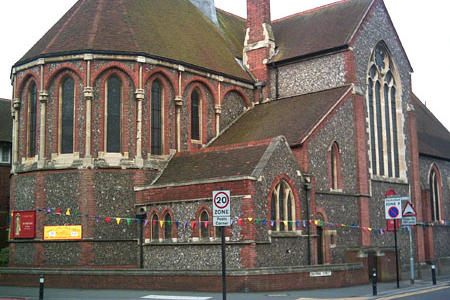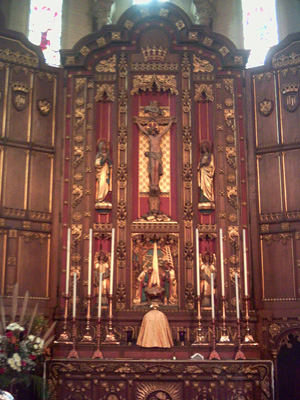| |
 |
 |
 |
| Comment on this report, or find other reports. |
 |
| Our Mystery Worshippers are volunteers who warm church pews for us around the world. If you'd like to become a Mystery Worshipper, start here. |
 |
| Find out how to reproduce this report in your church magazine or website. |
|
|
| 1589: St Barnabas,
Hove, East Sussex, England |
 |
 |
 |
Mystery Worshipper:
Deputy Verger.
The church:
St
Barnabas, Hove, East Sussex, England.
Denomination:
Church of England, Diocese
of Chichester.
The building:
It's a mid-Victorian (1883) suburban parish church in the Decorated
Gothic style, designed by the Gothic architect John Loughborough
Pearson. Pearson allegedly dismissed St Barnabas, however, as
"one of my cheap editions." It's quite imposing for
its size, being of dark flint decorated with red brick and stone.
There is a small spire above the crossing – Pearson designed
it to have a bell tower, which hasn't happened yet. From the
outside, the apse makes an attractive statement on the corner
of a busy road. Indoors, the nave is spacious, with graceful
pillars rising to the rafters. The high altar is backed by a
massive gold reredos by the 19th century high Gothicist George
Frederick Bodley. There are proper confessionals. There are
a great many shrines with statues, flowers, and candle stands,
including a flamboyant Sacred Heart of Jesus in a golden gown
with a red cloak. The Virgin Mary is there, and St Joseph. St
Barnabas is prominent of course, as is St Richard of Chichester.
The church possesses several relics, including one of the True
Cross. On the west wall is hung an enormous (10'x17') painting,
possibly by the Romantic artist John Henry Fuseli, reproducing
da Vinci's Last Supper. Both the painting and the reredos
seem slightly too large for the space they occupy, but they
are magnificent and the church is well worth visiting just to
see them. Modern chandeliers seem out of place.
The church:
St Barnabas is a Forward in Faith parish and is served by priests
of the Society
of the Holy Cross. It's at the traditional Catholic end
of the worship scale. Sunday mass is celebrated, according to
their website, "with full ceremonial ... appealing to all
our senses." Mass is celebrated daily except Mondays, with
a healing mass on Wednesdays and a Walsingham mass (said for
the intention of the shrine of Our Lady of Walsingham) on one
Saturday each month. The Rosary is prayed on the first Saturday
of the month. There is also a Sunday school, and children play
active roles in the services.
The neighbourhood:
The church is in a suburb of the city of Brighton and Hove known
as Poet's Corner, presumably because of local streets named
Shakespeare, Coleridge, Byron etc. It's very handy to Hove station
(originally known as West Brighton station) on the main line
to London and also convenient to the towns lying along the Sussex
and Hampshire coast to the west.
The cast:
The Rt Revd Roger Jupp, SSC, former bishop of Popondota in Papua
New Guinea and present vicar of St Leonards on Sea, East Sussex,
was celebrant and preacher. He was assisted by the Revd Deacon
James Hawkey. Attending in choir were the Revd Alan Reed, SSC,
vicar of St Barnabas, along with a great number of guest clergy.
The vicar also read the announcements. The organist and director
of music was the church's former organist, Malcolm Kemp (now
at nearby Good Shepherd, Brighton), who put together a visiting
choir of voices from parishes in Brighton, Hove and Worthing.
It was clear that an effort had been made to involve people
for whom the church is special. It was mentioned in the bulletin
that the deacon, who was ordained to the priesthood shortly
after this service and is now curate of St Mary's, Portsea,
Hampshire, was "fostered from this parish" to his
vocation.
The date & time:
St Barnabas Day, Feast of Title and 125th anniversary of the
consecration of the church, 11 June 2008, 7.30pm.
What was the name of the service?
Solemn Pontifical Mass.
How full was the building?
Quite full. There were not many empty seats, and not many solo
worshippers.
Did anyone welcome you personally?
A woman handed me a nicely produced 16-page special booklet
for the occasion, and a Gift-Aid envelope (Gift-Aid allows charities
to increase the value of a donation by the amount of tax that
the donor would have paid), but she was a bit distracted by
a constant stream of guest clergy arriving and needing directions
to the vestry. She didn't really notice me.
Was your pew comfortable?
They were those joined-up wooden chairs, but there was so much
standing-sitting-kneeling going on that they didn't have time
to get uncomfortable.
How would you describe the pre-service
atmosphere?
When I arrived I could hear the choir practicing, which was lovely, but there was so much chatting going on in the nave that I didn't notice when they stopped.
What were the exact opening
words of the service?
The service began with a profusion of priests, a confusion of
clergy, who processed en masse to the statue of St Barnabas.
There, the bishop censed the statue and intoned, "Let us
pray." He then chanted a collect and prayer, after which
the procession resumed. It took 15 minutes for everyone to reach
the altar! The first spoken words were: "In the name of the
Father, and of the Son, and of the Holy Spirit."
What books did the congregation
use during the service?
The New English Hymnal was in the pews, but everything
we needed (including hymns) was contained in the special service
booklet.
What musical instruments were played?
The organ.
Did anything distract you?
Two or three quite loud and somewhat out of time and off-key
members of the congregation, who made the responses and the
hymns a bit erratic. It was my bad luck to be sitting rather
close to a couple of them.
Was the worship stiff-upper-lip, happy clappy, or
what?
It was all smells and bells, but it wasn't stiff. There was
a huge altar party but only two of them were really gloriously
vested in red for the occasion (the bishop and the deacon).
There was applause during the notices when the vicar thanked
the music director and the choir and organist, and gave the
bishop a thank-you present, but there was no clapping in the
sense of this question! It was a jolly affair, and people had
come from far and wide to celebrate it, but they did so to a
"high" standard!

Exactly how long was the sermon?
13 minutes.
On a scale of 1-10, how
good was the preacher?
7 – The bishop spoke clearly and with authority –
he was a bishop after all! He kept it simple, perhaps slightly
too simple for my taste, but it was appropriate for the occasion.
In a nutshell, what was
the sermon about?
He told the story of St Barnabas, a central and essential apostle
though not one of the twelve. The name Barnabas means "son
of encouragement" and thus he is often called St Barnabas
the Encourager. St Francis of Assisi may have been thinking
of Barnabas when he said, "Go out and preach the gospel.
Use words if necessary." The eucharist is a great celebration
of thanksgiving, and thanksgiving leads to evangelising.
Which part of the service
was like being in heaven?
Put together, the massive altar party, the smells and bells,
the organ and the choir, the building so full of people on a
Wednesday evening, the sense of occasion. It was the general
energy of worship and praise which was really uplifting.
And which part was like being in... er... the other place?
Well, I felt quite self-conscious being alone, as most people
were in couples or families, and then there was the truly dire
singing near me which intruded badly and made it hard to hear
the choir.
What happened when you hung around after the service looking lost?
To be fair, it was a party with a lot of guests, invited and
otherwise. I was not the only stranger. In other words, I was
left to help myself to the refreshments. I was also left unmolested
to wander round the church admiring the statues and shrines
and relics, which suited me fine.
How would you describe the after-service
coffee?
Well, it was a feast befitting a feast day and a big birthday
celebration. There were tables groaning under the weight of
the food which had been prepared and donated by legions of loyal
parishioners. More to the point, there was wine and juice. So,
no need for coffee. Besides, it was evening.
How would you feel about making this church your regular (where 10 = ecstatic, 0 = terminal)?
8– It was lovely, architecturally, musically, liturgically.
I liked it a lot. But I can't give a 10 to a church that has
no bells. Sorry.
Did the service make you feel glad to be a
Christian?
Yes, it pushed all the right buttons for me.
What one thing will you remember about all this in seven days' time?
The sense of occasion, the heavy aura of holy smoke by the end
of the service. It's so rare these days. And that amazing copy
of the Last Supper. |
|
|
 |
 |
 |
| We rely on voluntary donations to stay online. If you're a regular visitor to Ship of Fools, please consider supporting us. |
 |
 |
 |
| The Mystery Pilgrim |
 |
| One of our most seasoned reporters makes the Camino pilgrimage to Santiago de Compostela in Spain. Read here. |
 |
 |
 |
| London churches |
 |
| Read reports from 70 London churches, visited by a small army of Mystery Worshippers on one single Sunday. Read here. |
| |
|
|
|
|


